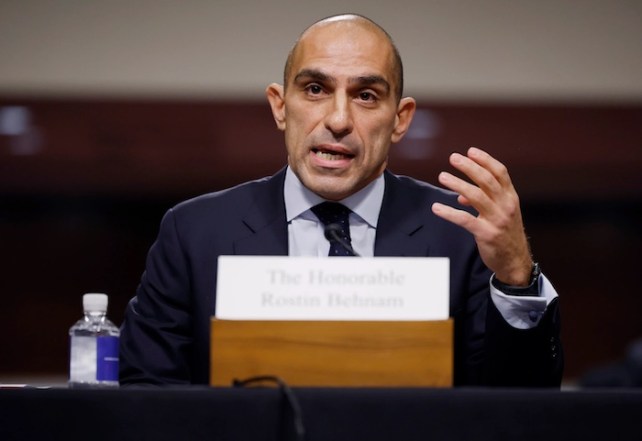
This story was originally published by Grist and is reproduced here as part of the Climate Desk collaboration.
Across the United States, more and more companies are pledging to zero out their greenhouse gas emissions using “voluntary carbon offsets”—credits that represent some amount of climate pollution that’s either prevented or removed from the atmosphere.
These credits, bought and sold on unregulated markets that are expected to be worth up to $100 billion by 2030, have long drawn criticism for failing to deliver on their promised emission reductions. Some credits come from projects that claim to protect forests that were never in danger of being cut down. Others pull carbon out of the air, but only temporarily, or are susceptible to “double-counting,” in which the same credits are claimed by two separate organizations. Experts have described offsets as a “climate scam” and the voluntary market for them a “Wild West.”
Now, federal regulatory agencies are beginning to take note. One of these is the Commodity Futures Trading Commission, or CFTC, an independent government body charged with ensuring the stability of the country’s derivatives markets. This week, the commission held its second roundtable discussion on promoting “integrity for high quality carbon credit derivatives,” and other recent actions suggest that it’s gearing up for a more proactive regulatory role in this space.
Last month, for example, the CFTC released a whistleblower alert asking the public for tips about fraud and manipulation in voluntary carbon markets—a “precursor” to bringing enforcement actions against market manipulators, according to Todd Phillips, a fellow at the think tank the Roosevelt Institute. Just a few days later, the CFTC announced a new Environmental Fraud Task Force within its enforcement division, to help investigate cases of “fraud and misconduct” in offset-related markets.
“The CFTC is uniquely situated to address this issue,” Phillips said. “There really is no one else.”
Exactly how they’ll do it, however, is uncertain.
The Commodity Futures Trading Commission, created by Congress in 1974, regulates the US markets for derivatives, contracts between parties in which prices are derived from the value of an underlying asset or benchmark. Such contracts can help hedge against risk; a futures contract, for example, guarantees the price for which a given asset will be sold at some point in the future. Farmers often use these kinds of contracts to guarantee their crops will sell for an agreed-upon price at the end of the harvest, protecting them from a downward swing in the market. Meanwhile, the CFTC’s job is to ensure that the crops actually get delivered, as per the contract.

Rostin Behnam, chair of the CFTC.
Chip Somodevilla/Getty/Grist
This is all relatively straightforward when it comes to derivatives involving tangible commodities like wheat, which the CFTC has long regulated. But it’s more complicated when it comes to carbon offsets. Offset credits are usually approved by unregulated standard-setters, sold to brokers, and then purchased by a company or organization to count toward their decarbonization pledges—often via a futures contract, if the emissions offset has yet to happen and is promised to occur at some point in the future.
Compared to wheat, it’s much less obvious what counts as the legitimate delivery of a carbon credit. Many market participants are concerned that if the underlying commodity—the offset—is based on fraudulent assumptions and does not actually cancel out climate pollution, then derivatives based on those commodities are also fraudulent.
This is already a huge problem; experts have noted “widespread perverse incentives” among market participants to inflate the climate benefits of their carbon credits. Buyers are motivated by low prices, for instance, and unregulated standard-setters run carbon credit registries that charge fees based on the volume of credits bought and sold, incentivizing them to set looser standards to enable more sales. Already, millions of rainforest-related credits approved by Verra, the world’s largest standard-setter for the voluntary carbon markets, have been shown to be “nonadditional,” meaning they didn’t yield additional emission reductions on top of what would have been expected if the credits didn’t exist.
Robin Rix, Verra’s chief legal, policy, and markets officer, acknowledged at the CFTC roundtable on Wednesday that voluntary carbon markets have characteristics that make them “vulnerable to abuse by malicious actors.” But he said it’s a “misconception” that voluntary carbon markets lack transparency and said his organization would support “a more muscular approach to fraud and market manipulation” from the CFTC.
Verra controls two-thirds of the world’s voluntary carbon markets. The rest are largely dominated by just three other private registries: the Climate Action Reserve, Gold Standard, and the American Carbon Registry.
The CFTC has so far not waded into this morass, although many experts, advocacy groups, and even private businesses would like it to. Following the commission’s first public convening on voluntary carbon markets last year, dozens of organizations responded to a request for information by saying that the CFTC should develop standards for carbon offsets that “effectively reduce greenhouse gas emissions and can serve as underlying commodities for approved derivatives.”
Freya Chay, program lead for the climate data nonprofit CarbonPlan, said such standards should require voluntary carbon markets to clearly distinguish between offsets that prevent carbon emissions—like if a project developer builds a wind farm rather than a coal plant—and those that remove carbon from the atmosphere. She also called for greater transparency around the “permanence” of removal-based offsets, i.e., how long they will keep carbon locked up. CO2 lasts around 1,000 years in the atmosphere. Meanwhile, carbon credits derived from offset projects like tree-planting—which might only keep carbon sequestered for a dozen years, since forests are susceptible to wildfires and illegal logging—are often treated the same as those derived from geological sequestration, in which carbon is injected into rock formations and is more likely to stay put.
It’s not clear, however, whether a definition of what constitutes a high-quality carbon offset will come from the CFTC. Many speakers at Wednesday’s roundtable said that, in order to allow the voluntary carbon markets to “reach their full potential,” the commission should leave definitional work to the private sector, perhaps in the hands of an independent body called the Integrity Council for Voluntary Carbon Markets. One speaker, representing an advocacy group for forest owners, called for the CFTC to only regulate with “a light touch” that allows standard-setters like Verra to continue to “innovate.”
Phillips, with the Roosevelt Institute, said the CFTC should simply hold standard-setters responsible for the claims they make. During the roundtable, he emphasized three words: “enforcement, enforcement, enforcement.”
Groups like Verra or the American Carbon Registry “have standards that say if you meet these standards, your offsets will count as one ton of carbon emissions reduced,” Phillips said in an interview with Grist. “If they make these assertions while knowing that they’re not true, that’s fraud.” In such a case, the CFTC could impose civil monetary penalties, freeze assets, or restrict an organization’s trading privileges. The commission could also refer the case to the Justice Department for prosecution.
As carbon markets grow, it’s likely that the CFTC’s efforts will complement or even overlap with work from other federal agencies to prevent offsets-related greenwashing. The Securities and Exchange Commission, for example—an independent regulatory agency in charge of protecting investors—has proposed rules that would require companies to disclose “certain information” about offsets they use, although it’s not yet clear what kind of information this would include.
Some experts say another agency, the Federal Trade Commission—tasked with enforcing the United States’ consumer protection laws—could step in by including a more concrete (albeit nonbinding) definition of a high-quality carbon offset in its soon-to-be-updated guidelines for environmental marketing claims.
Phillips, however, is pinning his hopes on the CFTC, which he said has shown the most interest in bringing enforcement actions. Indeed, commissioners on Wednesday spoke forcefully about the need to clean up the voluntary carbon markets.
“The rapid growth of these markets requires the commission’s careful attention,” Commissioner Kristin Johnson told attendees. “Our common goal must be to adopt a transparent path that effectively prevents double-counting, ensures additionality, and prevents fraud.”
The CFTC has issued another request for information from the public and is accepting submissions until August 18.















